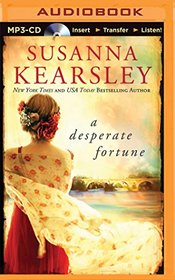Helpful Score: 2
I have enjoyed every book by Susanna Kearsley that I've read. I slipped into the story of A Desperate Fortune and really didn't come up for air until I'd read the last page. If there are any Diana Gabaldon or Mary Stewart fans out there who haven't read Susanna Kearsley, I urge them to do so.
I found both storylines absorbing. Sara's Asperger's is dealt with objectively, and her work in breaking Mary's code is a treat to watch. Mary's storyline really gives readers a feel for what exiled Jacobites had to endure. I also appreciated the similarities between the two women. As far as the secondary characters go, I like Sara's love interest, Luc, but found his history with his ex almost too good to be true. Sara and Luc's son Noah are definitely my favorite present-day characters. But what about Mary's time? Mary's traveling companions Madame Roy and MacPherson are wonderful, and so is Mary's dog, Frisque. And as far as competing love interests go, Mary's wins, hands down.
Although A Desperate Fortune is a standalone novel, recurring characters from previous books do make brief appearances, which will please Kearsley's fans. While being immersed in Paris and secret codes and exciting escapes and handsome men, I also learned some fascinating details about the fairy tales of Madame d'Aulnoy and the role she and other women writers of that time played in literature. (The things you don't learn in school....)
Yes, I love this book, and if I can leave you with any advice, it's this: please don't skip reading "About the Characters" at the very end. Kearsley's telling us about the real Mary Dundas brought a smile and a tear to my eye.
I found both storylines absorbing. Sara's Asperger's is dealt with objectively, and her work in breaking Mary's code is a treat to watch. Mary's storyline really gives readers a feel for what exiled Jacobites had to endure. I also appreciated the similarities between the two women. As far as the secondary characters go, I like Sara's love interest, Luc, but found his history with his ex almost too good to be true. Sara and Luc's son Noah are definitely my favorite present-day characters. But what about Mary's time? Mary's traveling companions Madame Roy and MacPherson are wonderful, and so is Mary's dog, Frisque. And as far as competing love interests go, Mary's wins, hands down.
Although A Desperate Fortune is a standalone novel, recurring characters from previous books do make brief appearances, which will please Kearsley's fans. While being immersed in Paris and secret codes and exciting escapes and handsome men, I also learned some fascinating details about the fairy tales of Madame d'Aulnoy and the role she and other women writers of that time played in literature. (The things you don't learn in school....)
Yes, I love this book, and if I can leave you with any advice, it's this: please don't skip reading "About the Characters" at the very end. Kearsley's telling us about the real Mary Dundas brought a smile and a tear to my eye.
Helpful Score: 1
to start off, I am a big Kearsley fan from the 1990's when I first discovered her books in New Zealand and Canada book stores. I think this book is the weakest of nearly all that I have managed to get my hands on. But I still enjoyed nearly all of the two storylines.
I think the less abundant presence of mystery is the key to my reaction. There is suspense as Mary and her companions try to evade the British spies and agents. You don't really understand why one of these travellers is so shifty until Kearsley's Athor's Notes at the end. Her other novels usually has a sense that there is something hidden beneath what was said or done. Maybe Mary's story is about exiled Jacobites who are more desperate than 20-years earlier, before two failed attempts to regain King James his throne. The Russia and Scotland installments were part of the intriques to these invasions. This storyline is about a court in retreat.
That said, I rooted for both Mary and Sara. and really appreciated the careful research on both normal life in rural and urban France and the function of fairy tales in that time. The snippets of Mary's fairy tale we heard complemented another book on the history of fairy tales I was reading in parallel, by coincidence.
So I guess my reaction can be summarized by this parody: Read it. Enjoyed it. Pass it on. (or return it to the library, in my case.)
--
Kuzu
PS. Any typos are strictly the iPad's fault!
I think the less abundant presence of mystery is the key to my reaction. There is suspense as Mary and her companions try to evade the British spies and agents. You don't really understand why one of these travellers is so shifty until Kearsley's Athor's Notes at the end. Her other novels usually has a sense that there is something hidden beneath what was said or done. Maybe Mary's story is about exiled Jacobites who are more desperate than 20-years earlier, before two failed attempts to regain King James his throne. The Russia and Scotland installments were part of the intriques to these invasions. This storyline is about a court in retreat.
That said, I rooted for both Mary and Sara. and really appreciated the careful research on both normal life in rural and urban France and the function of fairy tales in that time. The snippets of Mary's fairy tale we heard complemented another book on the history of fairy tales I was reading in parallel, by coincidence.
So I guess my reaction can be summarized by this parody: Read it. Enjoyed it. Pass it on. (or return it to the library, in my case.)
--
Kuzu
PS. Any typos are strictly the iPad's fault!




